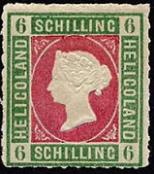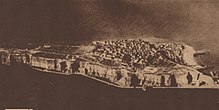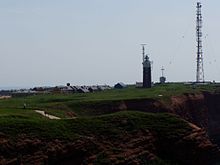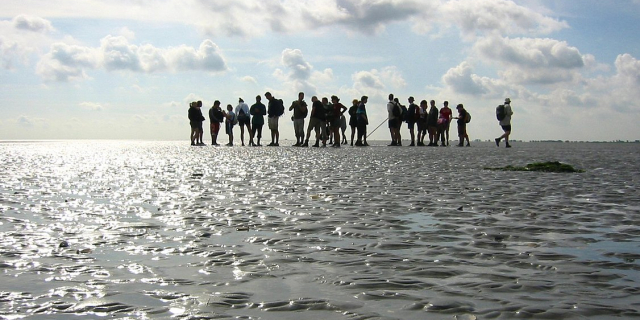Heligoland
Heligoland (; German: Helgoland, pronounced [ˈhɛlɡoˌlant] ; Heligolandic Frisian: deät Lun, lit. 'the Land', Mooring Frisian: Hålilönj, Danish: Helgoland) is a small archipelago in the North Sea. A part of the German state of Schleswig-Holstein since 1890, the islands were historically possessions of Denmark, then became the possessions of the United Kingdom from 1807 to 1890, and briefly managed as a war prize from 1945 to 1952.
The islands are located in the Heligoland Bight (part of the German Bight) in the southeastern corner of the North Se...Read more
Heligoland (; German: Helgoland, pronounced [ˈhɛlɡoˌlant] ; Heligolandic Frisian: deät Lun, lit. 'the Land', Mooring Frisian: Hålilönj, Danish: Helgoland) is a small archipelago in the North Sea. A part of the German state of Schleswig-Holstein since 1890, the islands were historically possessions of Denmark, then became the possessions of the United Kingdom from 1807 to 1890, and briefly managed as a war prize from 1945 to 1952.
The islands are located in the Heligoland Bight (part of the German Bight) in the southeastern corner of the North Sea and had a population of 1,127 at the end of 2016. They are the only German islands not in the vicinity of the mainland. They lie approximately 69 kilometres (43 miles) by sea from Cuxhaven at the mouth of the River Elbe. During a visit to the islands, August Heinrich Hoffmann von Fallersleben wrote the lyrics to "Deutschlandlied", which became the national anthem of Germany.
In addition to German, the local population, who are ethnic Frisians, speak the Heligolandic dialect of the North Frisian language called Halunder.
 Bird's eye view, Heligoland, c. 1890–1900
Bird's eye view, Heligoland, c. 1890–1900 Prehistoric cist grave from Heligoland, now in Berlin's Neues Museum
Prehistoric cist grave from Heligoland, now in Berlin's Neues MuseumThe German Bight and the area around the island are known to have been inhabited since prehistoric times. Flint tools have been recovered from the bottom of the sea surrounding Heligoland. On the Oberland, prehistoric burial mounds were visible until the late 19th century, and excavations showed skeletons and artefacts. Moreover, prehistoric copper plates have been found under water near the island; those plates were almost certainly made on the Oberland.[1]
In 697, Radbod, the last Frisian king, retreated to the then-single island after his defeat by the Franks – or so it is written in the Life of Willebrord by Alcuin. By 1231, the island was listed as the property of the Danish king Valdemar II. Archaeological findings from the 12th to 14th centuries suggest that copper ore was processed on the island.[2][page needed]
There is a general understanding that the name "Heligoland" means "Holy Land" (compare modern Dutch and German heilig, "holy").[3] In the course of the centuries several alternative theories have been proposed to explain the name, from a Danish king Heligo to a Frisian word, hallig, meaning "salt marsh island". The 1911 Encyclopædia Britannica suggests Hallaglun, or Halligland, i.e. "land of banks, which cover and uncover".[4]
Traditional economic activities included fishing, hunting birds and seals, wrecking and – very important for many overseas powers – piloting overseas ships into the harbours of Hanseatic League cities such as Bremen and Hamburg. In some periods Heligoland was an excellent base point for huge herring catches. Until 1714 ownership switched several times between Denmark–Norway and the Duchy of Schleswig, with one period of control by Hamburg. In August 1714, it was conquered by Denmark–Norway, and it remained Danish until 1807.[5]
19th century Postage stamp showing Queen Victoria and denominated in Hamburg schillings. From 1875 its postage stamps were denominated in both sterling and gold marks.
Postage stamp showing Queen Victoria and denominated in Hamburg schillings. From 1875 its postage stamps were denominated in both sterling and gold marks.On 11 September 1807, during the Napoleonic Wars, HMS Carrier brought to the Admiralty the despatches from Admiral Thomas Macnamara Russell announcing Heligoland's capitulation to the British.[6] Heligoland became a centre of resistance and intrigue against Napoleon. Denmark then ceded Heligoland to George III of the United Kingdom by the Treaty of Kiel (14 January 1814). Thousands of Germans came to Britain and joined the King's German Legion via Heligoland.
The British annexation of Heligoland was ratified by the Treaty of Paris signed on 30 May 1814, as part of a number of territorial reallocations following the abdication of Napoleon as Emperor of the French.
The prime reason at the time for Britain's retention of a small and seemingly worthless acquisition was to restrict any future French naval aggression against the Scandinavian or German states.[7] In the event, no effort was made during the period of British administration to make use of the islands for military purposes, partly for financial reasons but principally because the Royal Navy considered Heligoland to be too exposed as a forward base.[8]
In 1826, Heligoland became a seaside spa and soon turned into a popular tourist resort for the European upper class. The island attracted artists and writers, especially from Germany and Austria who apparently enjoyed the comparatively liberal atmosphere, including Heinrich Heine and August Heinrich Hoffmann von Fallersleben. More vitally it was a refuge for revolutionaries of the 1830s and the 1848 German revolution.
 Marriage Proposal in Heligoland by Rudolf Jordan, 1843
Marriage Proposal in Heligoland by Rudolf Jordan, 1843As related in The Leisure Hour, it was "a land where there are no bankers, no lawyers, and no crime; where all gratuities are strictly forbidden, the landladies are all honest and the boatmen take no tips",[9] while The English Illustrated Magazine provided a description in the most glowing terms: "No one should go there who cannot be content with the charms of brilliant light, of ever-changing atmospheric effects, of a land free from the countless discomforts of a large and busy population, and of an air that tastes like draughts of life itself."[10]
Britain ceded the islands to Germany in 1890 in the Heligoland–Zanzibar Treaty. The newly unified Germany was concerned about a foreign power controlling land from which it could command the western entrance to the militarily-important Kiel Canal, then under construction along with other naval installations in the area and thus traded for it. A "grandfathering"/optant approach prevented the inhabitants of the islands from forfeiting advantages because of this imposed change of status.
Heligoland has an important place in the history of the study of ornithology, and especially the understanding of migration. The book Heligoland, an Ornithological Observatory by Heinrich Gätke, published in German in 1890 and in English in 1895, described an astonishing array of migrant birds on the island and was a major influence on future studies of bird migration.[11]
In 1892, the Biological Station of Helgoland was founded by phycologist Paul Kuckuck, a student of Johannes Reinke (leading marine phycologist).[12]
20th century Aerial photograph showing new fortifications in 1919
Aerial photograph showing new fortifications in 1919 Heligoland about 1929–1930
Heligoland about 1929–1930Under the German Empire, the islands became a major naval base, and during the First World War the civilian population was evacuated to the mainland. The island was fortified with concrete gun emplacements along its cliffs similar to the Rock of Gibraltar. Island defences included 364 mounted guns including 142 42-centimetre (17 in) disappearing guns overlooking shipping channels defended with ten rows of naval mines.[13] The first naval engagement of the war, the Battle of Heligoland Bight, was fought nearby in the first month of the war. The islanders returned in 1918, but during the Nazi era the naval base was reactivated.
Werner Heisenberg (1901–1976) first formulated the equation underlying his theory of quantum mechanics while on Heligoland in the 1920s. While a student of Arnold Sommerfeld at Munich, Heisenberg first met the Danish physicist Niels Bohr in 1922 at the Bohr Festival, Gottingen.[14] He and Bohr went for long hikes in the mountains and discussed the failure of existing theories to account for the new experimental results on the quantum structure of matter. Following these discussions, Heisenberg plunged into several months of intensive theoretical research but met with continual frustration. Finally, suffering from a severe attack of hay fever that his aspirin and cocaine treatment was failing to alleviate,[15] he retreated to the treeless (and pollenless) island of Heligoland in the summer of 1925. There he conceived the basis of the quantum theory.
In 1937, construction began on a major reclamation project (Project Hummerschere) intended to expand existing naval facilities and restore the island to its pre-1629 dimensions, restoring large areas which had been eroded by the sea. The project was largely abandoned after the start of World War II and was never completed.
World War IIThe area was the setting of the aerial Battle of the Heligoland Bight in 1939, a result of Royal Air Force bombing raids on Kriegsmarine warships in the area. The waters surrounding the island were frequently mined by Allied aircraft.
Heligoland also had a military function as a sea fortress in the Second World War. Completed and ready for use were the submarine bunker North Sea III, the coastal artillery, an air-raid shelter system with extensive bunker tunnels and the airfield with the air force – Jagdstaffel Helgoland (April to October 1943).[16] Forced labour of, among others, citizens of the Soviet Union was used during the construction of military installations during World War II.[17]
On 3 December 1939, Heligoland was directly bombed by the Allies for the first time. The attack, by twenty four Wellington bombers of 38, 115 and 149 squadrons of the Royal Air Force failed to destroy the German warships at anchor.[18]
In three days in 1940, the Royal Navy lost three submarines in Heligoland: HMS Undine on 6 January, Seahorse on 7 January and Starfish on 9 January.[19]
Early in the war, the island was generally unaffected by bombing raids. Through the development of the Luftwaffe, the island had largely lost its strategic importance. The Jagdstaffel Helgoland, temporarily used for defense against Allied bombing raids, was equipped with a rare variant of the Messerschmitt Bf 109 fighter originally designed for use on aircraft carriers.
Shortly before the war ended in 1945, Georg Braun and Erich Friedrichs succeeded in forming a resistance group. Shortly before they were to execute the plans, however, they were betrayed by two members of the group. About twenty men were arrested on 18 April 1945; fourteen of them were transported to Cuxhaven. After a short trial, five resisters were executed by firing squad at Cuxhaven-Sahlenburg on 21 April 1945 by the German authorities.[20]
To honour them, in April 2010 the Helgoland Museum installed six stumbling blocks on the roads of Heligoland. Their names are Erich P. J. Friedrichs, Georg E. Braun, Karl Fnouka, Kurt A. Pester, Martin O. Wachtel, and Heinrich Prüß.
With two waves of bombing raids on 18 and 19 April 1945, 1,000 Allied aircraft dropped about 7,000 bombs on the islands. The populace took shelter in air raid shelters. The German military suffered heavy casualties during the raids.[21] The bomb attacks rendered the island unsafe, and it was totally evacuated.
Bombing and mining of Heligoland during World War II Date/Target Result 11 March – 24 August 1944 No. 466 Squadron RAAF laid mines.[22]18 April 1944 No. 466 Squadron RAAF conducted bombing operations.[22]29 August 1944 Mission 584: 11 B-17 Flying Fortresses and 34 B-24 Liberators bomb Heligoland Island; 3 B-24s are damaged. Escort is provided by 169 P-38 Lightnings and P-51 Mustangs; 7 P-51s are damaged.[23]3 September 1944 Operation Aphrodite B-17 63954 attempt on U-boat pens[24] failed when US Navy controller flew aircraft into Düne Island by mistake. 11 September 1944 Operation Aphrodite B-17 30180 attempt on U-boat pens[24] hit by enemy flak and crashed into sea. 29–30 September 1944 15 Lancasters conducted minelaying in the Kattegat and off Heligoland. No aircraft lost.[25]5–6 October 1944 10 Halifaxes conducted minelaying off Heligoland. No aircraft lost.[25]15 October 1944 Operation Aphrodite B-17 30039 *Liberty Belle* and B-17 37743 attempt on U-boat pens[26] destroyed many of the buildings of the Unterland. 26–27 October 1944 10 Lancasters of No 1 Group conducted minelaying off Heligoland. 1 Lancaster minelayer lost.[25] and the islands were evacuated the following night. 22–23 November 1944 17 Lancasters conducted minelaying off Heligoland and in the mouth of the River Elbe without loss.[25]23 November 1944 4 Mosquitoes conducted Ranger patrols in the Heligoland area. No aircraft lost.[25]31 December 1944 On Eighth Air Force Mission 772, 1 B-17 bombed Heligoland island.[27]4–5 February 1945 15 Lancasters and 12 Halifaxes minelaying off Heligoland and in the River Elbe. No minelaying aircraft lost.[25]16–17 March 1945 12 Halifaxes and 12 Lancasters minelaying in the Kattegat and off Heligoland. No aircraft lost.[28]18 April 1945 969 aircraft (617 Lancasters, 332 Halifaxes, 20 Mosquitoes) bombed the Naval base, airfield, and village into crater-pitted moonscapes. 3 Halifaxes were lost. The islands were evacuated the following day.[29]19 April 1945 36 Lancasters of 9 and 617 Squadrons attacked coastal battery positions with Tallboy bombs for no losses.[29]Explosion

From 1945 to 1952 the uninhabited islands fell within the British Occupation zone. On 18 April 1947, the Royal Navy simultaneously detonated 6,700 tonnes of explosives ("Operation Big Bang" or "British Bang"), successfully destroying the island's principal military installations (namely, the submarine pens, the coastal batteries at the north and south ends of the island and 8½ miles of main storage tunnels) while leaving the town, already damaged by Allied bombing during the Second World War, "looking little worse" (according to an observer quoted in the Guardian newspaper).[30] The destruction of the submarine pens resulted in the creation of the Mittelland crater. The British later used the island, from which the population had been evacuated, as a bombing range. The explosion was one of the biggest single non-nuclear detonations in history.[31][32]
 20 pfennig commemorative stamp issued by Deutsche Bundespost to commemorate the 1952 restoration of HelgolandReturn of sovereignty to Germany
20 pfennig commemorative stamp issued by Deutsche Bundespost to commemorate the 1952 restoration of HelgolandReturn of sovereignty to Germany
On 20 December 1950, two students and a professor from Heidelberg – René Leudesdorff, Georg von Hatzfeld and Hubertus zu Löwenstein – occupied the off-limits island and raised various German, European and local flags.[33] The students were arrested by the soldiers present and brought back to Germany. The event started a movement to restore the islands to West Germany, which gained the support of the West German parliament. On 1 March 1952, Heligoland was returned to German control, and the former inhabitants were allowed to return.[34] The first of March is an official holiday on the island. The German authorities cleared a significant quantity of unexploded ordnance and rebuilt the houses before allowing its citizens to resettle there.
21st century Heligoland Lighthouse, control station of the Bundeswehr and network tower
Heligoland Lighthouse, control station of the Bundeswehr and network towerHeligoland, like the small exclave Büsingen am Hochrhein, is now a holiday resort and enjoys a tax-exempt status, being part of Germany and the EU but excluded from the EU VAT area and customs union.[35][36] Consequently, much of the economy is founded on sales of cigarettes, alcoholic beverages, and perfume to tourists who visit the islands. The ornithological heritage of Heligoland has also been re-established, with the Heligoland Bird Observatory, now managed by the Ornithologische Arbeitsgemeinschaft Helgoland e.V. ("Ornithological Society of Heligoland") which was founded in 1991. A search and rescue (SAR) base of the DGzRS, the Deutsche Gesellschaft zur Rettung Schiffbrüchiger (German Maritime Search and Rescue Service), is located on Heligoland.
Energy supplyBefore the island was connected to the mainland network by a submarine cable in 2009, electricity on Heligoland was generated by a local diesel plant.
Heligoland was the site of a trial of GROWIAN, a large wind-turbine testing project. In 1990, a 1.2 MW turbine of the MAN type WKA 60 was installed. Besides technical problems, the turbine was not lightning-proof and insurance companies would not provide coverage. The wind energy project was viewed as a failure by the islanders and was stopped.[37][38] The Heligoland Power Cable has a length of 53 kilometres (33 mi) and is one of the longest AC submarine power cables in the world and the longest of its kind in Germany.[39] It was manufactured by the North German Seacable Works in a single piece and was laid by the barge Nostag 10 in 2009. The cable is designed for an operational voltage of 30 kV, and reaches the German mainland at Sankt Peter-Ording.
Expansion plans and wind industryPlans to re-enlarge the land bridge between different parts of the island by means of land reclamation came up between 2008 and 2010.[40] However, the local community voted against the project.[41][42]
Since 2013, a new industrial site is being expanded on the southern harbour. E.ON, RWE and WindMW plan to manage operation and services of large offshore windparks from Heligoland.[43][44][45] The range had been cleared of leftover ammunition.[46]
































Add new comment